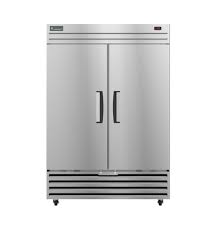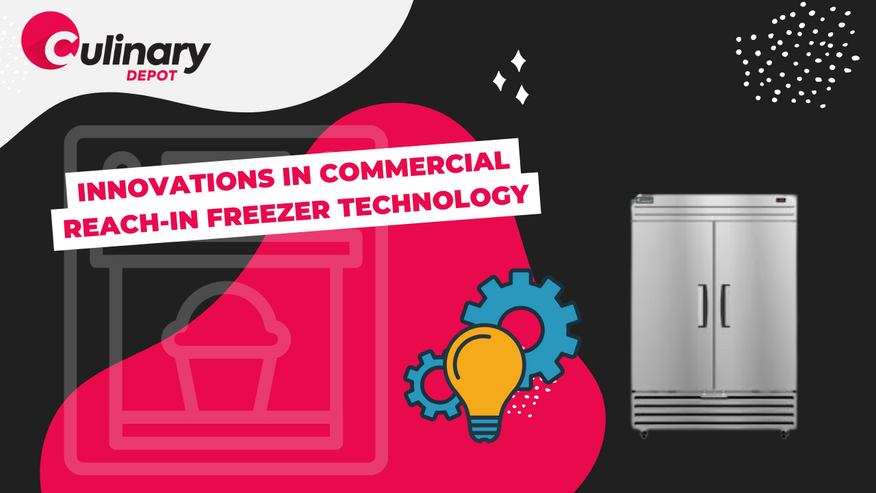Nov 29th 2023 - Team Member
Innovations in Commercial Reach-in Freezer Technology
In the ever-evolving world of commercial kitchens, reach-in freezers play a crucial role. The latest innovations in this essential equipment are transforming how foodservice professionals store, manage, and preserve their inventory. This article, presented by Culinary Depot delves deep into the cutting-edge advancements in commercial reach-in freezer technology, highlighting their impact on efficiency, sustainability, and kitchen operations.
Advanced Temperature Control Technologies
Enhancing Food Safety and Quality

The core function of a reach-in freezer is to maintain consistent temperatures, a critical factor in preserving food safety and quality.
Digital and Programmable Thermostats
Modern reach-ins are equipped with digital thermostats offering precise temperature control. Programmable features allow for automatic adjustments, adapting to different storage needs.
Uniform Cooling Systems
Advanced cooling systems ensure even temperature distribution, eliminating cold spots and guaranteeing consistent freezing.
Energy Efficiency and Environmental Impact
Reducing Operational Costs
Today's reach-in freezers are designed to minimize energy consumption, significantly reducing operational costs for foodservice businesses.
Energy Star Certified Models
Energy Star-rated freezers meet stringent energy efficiency standards, making them both cost-effective and environmentally friendly.
Next-Generation Refrigerants
The shift towards eco-friendly refrigerants, such as R290, reflects the industry's commitment to reducing its carbon footprint.
Smart Technology Integration
Revolutionizing Kitchen Management
The integration of smart technologies into reach-in freezers marks a significant advancement in kitchen management and efficiency.
IoT Connectivity
IoT-enabled freezers offer remote monitoring and control capabilities, allowing for efficient management and enhanced food safety compliance.
Predictive Analytics and Maintenance
Some models provide data analytics and predictive maintenance alerts, helping to preemptively address potential issues and reduce downtime.
Ergonomic Design and Accessibility
Prioritizing User Experience
The design of modern reach-in freezers focuses on user experience, making them more accessible and easier to use in a fast-paced kitchen environment.
User-Centric Design Features
Features such as sliding shelves, ergonomic handles, and easy-to-clean interiors enhance usability and efficiency.
Improved Visibility and Access
LED lighting and clear door panels improve visibility, making it easier to locate and access items quickly.
Material Innovations and Durability
Constructed for Longevity
The durability of reach-in freezers is paramount, with manufacturers using high-quality materials and robust construction techniques.
Stainless Steel and Other High-Grade Materials
The use of materials like stainless steel not only provides durability but also facilitates easy cleaning and maintenance.
Enhanced Insulation Technologies
Improved insulation materials and technologies enhance temperature retention and overall energy efficiency.
Compliance with Safety Standards
Meeting Health and Safety Regulations
Modern reach-in freezers are designed to comply with the latest health and safety standards, ensuring safe operation in commercial kitchens.
Safety Features
Innovations in safety features, such as alarm systems for temperature deviations and self-closing doors, further enhance the utility and safety of these units.
The Future of Freezer Technology
Looking Ahead
Emerging trends in freezer technology, such as AI integration and advanced touchscreen controls, are set to redefine the capabilities and efficiency of commercial freezers.
Anticipating Market Needs
Manufacturers continue to innovate, anticipating the future needs and challenges of the foodservice industry.
Cost-Benefit Analysis
Understanding the Investment
While the upfront cost of advanced models may be higher, the long-term savings in energy costs, maintenance, and improved efficiency present a compelling case for investment.
Calculating ROI
The return on investment for modern reach-in freezers includes factors such as energy savings, reduced food waste, and enhanced operational efficiency.
Conclusion
The advancements in commercial reach-in freezer technology represent a significant leap forward in kitchen efficiency, sustainability, and management. By staying abreast of these developments, foodservice professionals can make informed decisions that enhance their operations and contribute to a more sustainable future. For the latest insights into commercial kitchen equipment, visit Culinary Depot.

